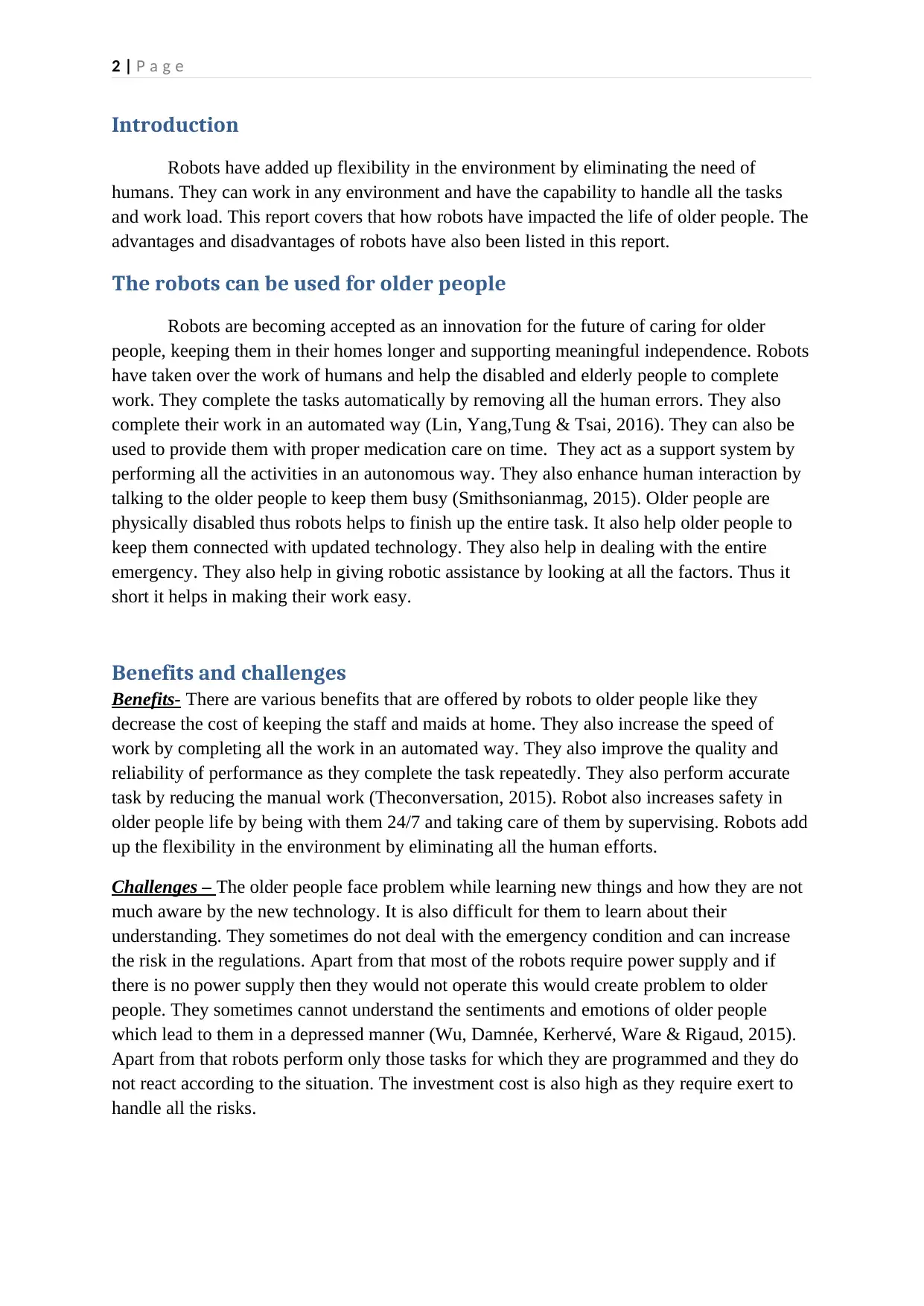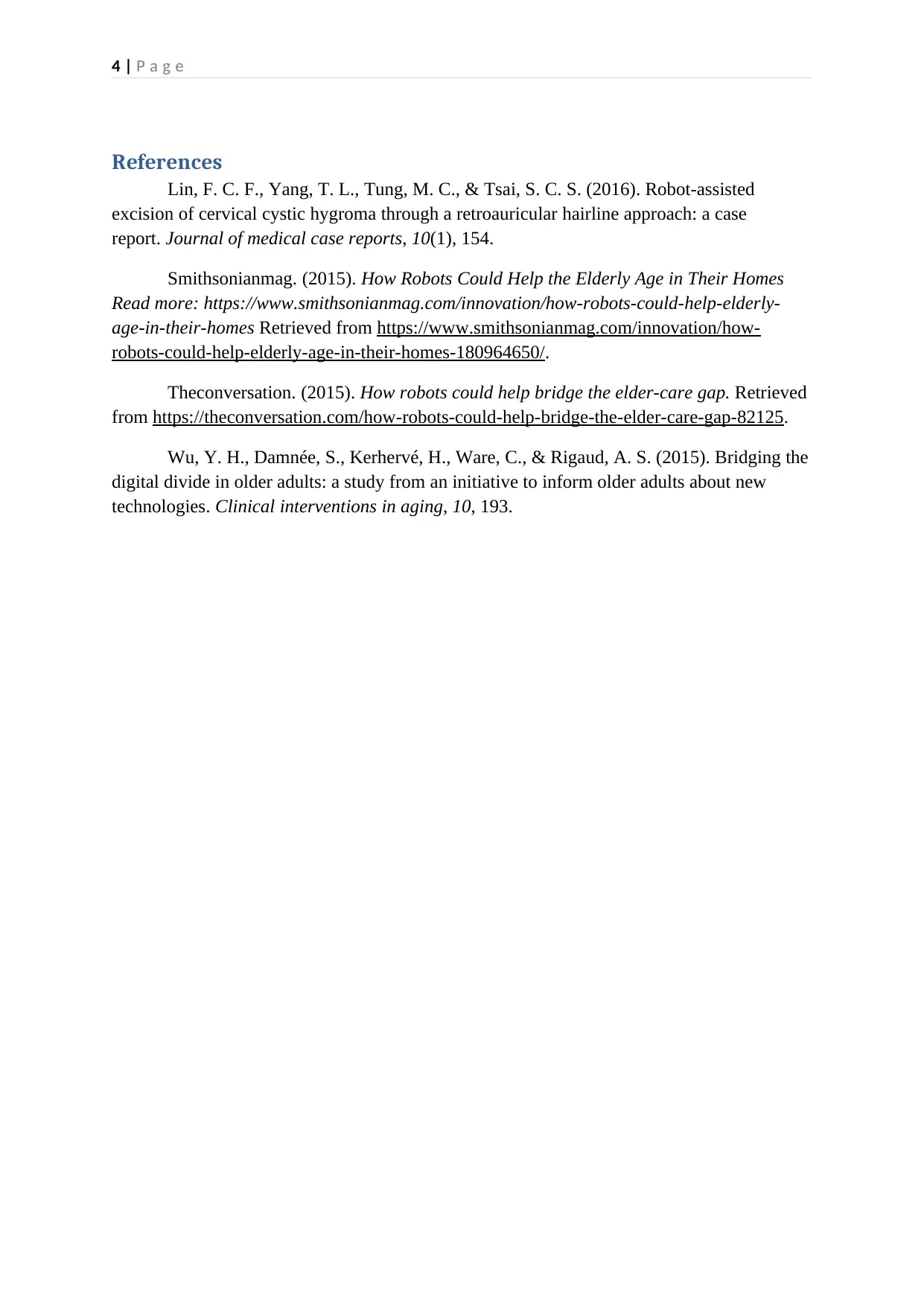Robotics in Geriatric Care: Assessing Benefits, Challenges, and Impact
VerifiedAdded on 2023/06/11
|5
|777
|464
Report
AI Summary
This report examines the impact of robots on the lives of older people, focusing on their potential to provide support, enhance independence, and improve overall quality of life. It highlights the benefits of using robots in elderly care, such as reducing the cost of in-home care, increasing the speed and reliability of task completion, and improving safety through constant supervision. However, it also addresses the challenges, including the difficulty older adults may face in learning to use new technology, the potential for robots to misunderstand emotions, and the limitations of robots in responding to unforeseen situations. The report concludes that while robots can significantly improve the lives of older adults by providing assistance and companionship, careful consideration must be given to addressing the challenges and ensuring that their use is ethically and practically sound.

health informatics
Paraphrase This Document
Need a fresh take? Get an instant paraphrase of this document with our AI Paraphraser

1 | P a g e
Table of Contents
Introduction...........................................................................................................................................1
The robots can be used for older people...............................................................................................1
Benefits and challenges.........................................................................................................................1
Conclusion.............................................................................................................................................3
References.............................................................................................................................................4
Table of Contents
Introduction...........................................................................................................................................1
The robots can be used for older people...............................................................................................1
Benefits and challenges.........................................................................................................................1
Conclusion.............................................................................................................................................3
References.............................................................................................................................................4

2 | P a g e
Introduction
Robots have added up flexibility in the environment by eliminating the need of
humans. They can work in any environment and have the capability to handle all the tasks
and work load. This report covers that how robots have impacted the life of older people. The
advantages and disadvantages of robots have also been listed in this report.
The robots can be used for older people
Robots are becoming accepted as an innovation for the future of caring for older
people, keeping them in their homes longer and supporting meaningful independence. Robots
have taken over the work of humans and help the disabled and elderly people to complete
work. They complete the tasks automatically by removing all the human errors. They also
complete their work in an automated way (Lin, Yang,Tung & Tsai, 2016). They can also be
used to provide them with proper medication care on time. They act as a support system by
performing all the activities in an autonomous way. They also enhance human interaction by
talking to the older people to keep them busy (Smithsonianmag, 2015). Older people are
physically disabled thus robots helps to finish up the entire task. It also help older people to
keep them connected with updated technology. They also help in dealing with the entire
emergency. They also help in giving robotic assistance by looking at all the factors. Thus it
short it helps in making their work easy.
Benefits and challenges
Benefits- There are various benefits that are offered by robots to older people like they
decrease the cost of keeping the staff and maids at home. They also increase the speed of
work by completing all the work in an automated way. They also improve the quality and
reliability of performance as they complete the task repeatedly. They also perform accurate
task by reducing the manual work (Theconversation, 2015). Robot also increases safety in
older people life by being with them 24/7 and taking care of them by supervising. Robots add
up the flexibility in the environment by eliminating all the human efforts.
Challenges – The older people face problem while learning new things and how they are not
much aware by the new technology. It is also difficult for them to learn about their
understanding. They sometimes do not deal with the emergency condition and can increase
the risk in the regulations. Apart from that most of the robots require power supply and if
there is no power supply then they would not operate this would create problem to older
people. They sometimes cannot understand the sentiments and emotions of older people
which lead to them in a depressed manner (Wu, Damnée, Kerhervé, Ware & Rigaud, 2015).
Apart from that robots perform only those tasks for which they are programmed and they do
not react according to the situation. The investment cost is also high as they require exert to
handle all the risks.
Introduction
Robots have added up flexibility in the environment by eliminating the need of
humans. They can work in any environment and have the capability to handle all the tasks
and work load. This report covers that how robots have impacted the life of older people. The
advantages and disadvantages of robots have also been listed in this report.
The robots can be used for older people
Robots are becoming accepted as an innovation for the future of caring for older
people, keeping them in their homes longer and supporting meaningful independence. Robots
have taken over the work of humans and help the disabled and elderly people to complete
work. They complete the tasks automatically by removing all the human errors. They also
complete their work in an automated way (Lin, Yang,Tung & Tsai, 2016). They can also be
used to provide them with proper medication care on time. They act as a support system by
performing all the activities in an autonomous way. They also enhance human interaction by
talking to the older people to keep them busy (Smithsonianmag, 2015). Older people are
physically disabled thus robots helps to finish up the entire task. It also help older people to
keep them connected with updated technology. They also help in dealing with the entire
emergency. They also help in giving robotic assistance by looking at all the factors. Thus it
short it helps in making their work easy.
Benefits and challenges
Benefits- There are various benefits that are offered by robots to older people like they
decrease the cost of keeping the staff and maids at home. They also increase the speed of
work by completing all the work in an automated way. They also improve the quality and
reliability of performance as they complete the task repeatedly. They also perform accurate
task by reducing the manual work (Theconversation, 2015). Robot also increases safety in
older people life by being with them 24/7 and taking care of them by supervising. Robots add
up the flexibility in the environment by eliminating all the human efforts.
Challenges – The older people face problem while learning new things and how they are not
much aware by the new technology. It is also difficult for them to learn about their
understanding. They sometimes do not deal with the emergency condition and can increase
the risk in the regulations. Apart from that most of the robots require power supply and if
there is no power supply then they would not operate this would create problem to older
people. They sometimes cannot understand the sentiments and emotions of older people
which lead to them in a depressed manner (Wu, Damnée, Kerhervé, Ware & Rigaud, 2015).
Apart from that robots perform only those tasks for which they are programmed and they do
not react according to the situation. The investment cost is also high as they require exert to
handle all the risks.
⊘ This is a preview!⊘
Do you want full access?
Subscribe today to unlock all pages.

Trusted by 1+ million students worldwide

3 | P a g e
Conclusion
It can be concluded that robots have made the lifestyle of older people by being their
support. It can be treated as a tool that completes the entire task on the demand. Some of the
benefits and challenges are listed in this report.
Conclusion
It can be concluded that robots have made the lifestyle of older people by being their
support. It can be treated as a tool that completes the entire task on the demand. Some of the
benefits and challenges are listed in this report.
Paraphrase This Document
Need a fresh take? Get an instant paraphrase of this document with our AI Paraphraser

4 | P a g e
References
Lin, F. C. F., Yang, T. L., Tung, M. C., & Tsai, S. C. S. (2016). Robot-assisted
excision of cervical cystic hygroma through a retroauricular hairline approach: a case
report. Journal of medical case reports, 10(1), 154.
Smithsonianmag. (2015). How Robots Could Help the Elderly Age in Their Homes
Read more: https://www.smithsonianmag.com/innovation/how-robots-could-help-elderly-
age-in-their-homes Retrieved from https://www.smithsonianmag.com/innovation/how-
robots-could-help-elderly-age-in-their-homes-180964650/.
Theconversation. (2015). How robots could help bridge the elder-care gap. Retrieved
from https://theconversation.com/how-robots-could-help-bridge-the-elder-care-gap-82125.
Wu, Y. H., Damnée, S., Kerhervé, H., Ware, C., & Rigaud, A. S. (2015). Bridging the
digital divide in older adults: a study from an initiative to inform older adults about new
technologies. Clinical interventions in aging, 10, 193.
References
Lin, F. C. F., Yang, T. L., Tung, M. C., & Tsai, S. C. S. (2016). Robot-assisted
excision of cervical cystic hygroma through a retroauricular hairline approach: a case
report. Journal of medical case reports, 10(1), 154.
Smithsonianmag. (2015). How Robots Could Help the Elderly Age in Their Homes
Read more: https://www.smithsonianmag.com/innovation/how-robots-could-help-elderly-
age-in-their-homes Retrieved from https://www.smithsonianmag.com/innovation/how-
robots-could-help-elderly-age-in-their-homes-180964650/.
Theconversation. (2015). How robots could help bridge the elder-care gap. Retrieved
from https://theconversation.com/how-robots-could-help-bridge-the-elder-care-gap-82125.
Wu, Y. H., Damnée, S., Kerhervé, H., Ware, C., & Rigaud, A. S. (2015). Bridging the
digital divide in older adults: a study from an initiative to inform older adults about new
technologies. Clinical interventions in aging, 10, 193.
1 out of 5
Related Documents
Your All-in-One AI-Powered Toolkit for Academic Success.
+13062052269
info@desklib.com
Available 24*7 on WhatsApp / Email
![[object Object]](/_next/static/media/star-bottom.7253800d.svg)
Unlock your academic potential
Copyright © 2020–2025 A2Z Services. All Rights Reserved. Developed and managed by ZUCOL.





